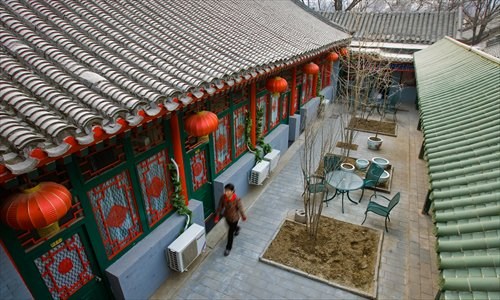
Foreigners appreciate the unique beauty and culture behind China's ancient architecture. (Photo: Li Hao/GT)
Foreigners dedicated to safeguarding the country's antiquities
British national William Lindesay, 59, gently sweeps his hand across every crack in the stone, as he walks along the Great Wall, picking up garbage and putting it in his pocket, as if he were cleaning up his own backyard.
For the past 29 years he has lived in China, Lindesay has walked through the bushes and deserts of 15 provinces, exploring one of China's most famous ancient relics, to learn more about the stories behind every aged brick. He founded a volunteer organization in 2001 called the International Friends of the Great Wall to regularly pick up the garbage left behind by tourists on their visits to the Wall, and to promote awareness about protecting one of the world's seven ancient wonders.
Lindesay is not the only foreigner who is taking an interest in the historical architecture of China and taking initiative to do what he can to help protect it.
Destructive forces
While in middle school, 11-year-old Lindesay saw a winding line in an atlas. It was the Great Wall stretching across deserts, barren mountains, and ending in the sea.
"That line made me indulge in reverie. From that moment, I decided that I would visit the Great Wall in person one day, and walk down that line in the atlas," Lindesay told the Southern People Weekly.
In 1987, at the age of 31, Lindesay finally came to China and managed to walk the 2,470 kilometers of the Great Wall from Jiayu Pass in Gansu Province to Shanhai Pass in Hebei Province. It took him 78 days.
The trip opened Lindesay's eyes to the beauty of the Great Wall and the rich culture behind it, but he also saw the "wounds" of the Great Wall, and the precarious state it was in due to the erosion and destruction caused by sandstorms over thousands of years, which had buried the beacon towers.
He also noticed how human forces had damaged the Great Wall. Livestock in the area would just walk over the wall, and animal herders would dig holes in it to take shelter from the rain, he said.
Once he witnessed a farmer using a hammer to chop bricks out of the wall while hiking near the Huanghuacheng section of the Great Wall.
"I tried to stop him, saying that the Great Wall is a historical relic and should not be destroyed. But the farmer told me that the walls are like his backyard. He owns it. He can do whatever he wants," Lindesay recalled. He then decided he should do something about the fragile physical state of the Wall.
His volunteer organization now has over 20,000 volunteers across the country who work on the protection of the Wall.
Lindesay promotes awareness about protecting the Wall through his "covenant of the wild," which has nine suggestions calling on tourists not to leave garbage behind or smoke on the Great Wall, and not to cause damage to it in any way.
In 2011, Lindesay hosted a photographic exhibition, showcasing more than 170 photos he had taken from his 30 years of exploration of the Great Wall, and comparing them to old photos taken by British explorer Marc Aurel Stein in 1907, to show the changes and destruction of the Wall in the past century.
"I took a picture of a beacon tower on Jiayu Pass that was shot by Stein 80 years ago. The beacon tower was in good shape then, but when I took the picture, the beacon tower was already in ruins," he told the Beijing News.
"The Great Wall is unique. I hope more could be done to protect the Great Wall and the culture behind it. I hope I could establish a major to study the Great Wall," he added.


















































